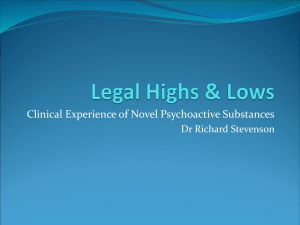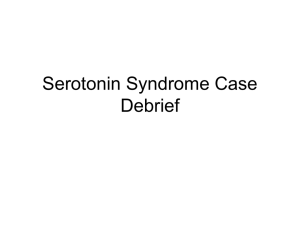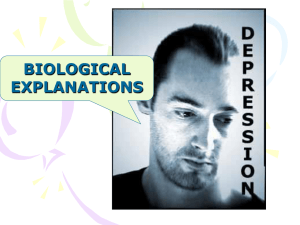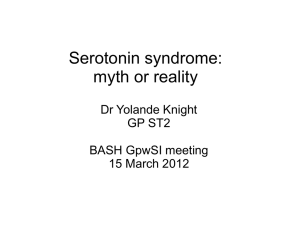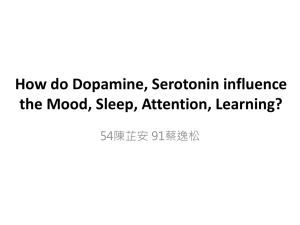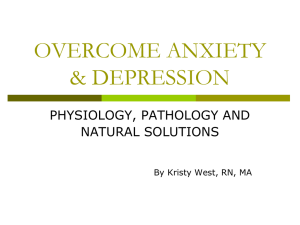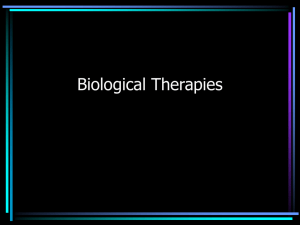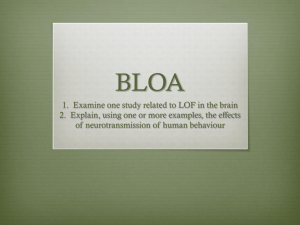Serotonin syndrome - NHS Evidence Search
advertisement
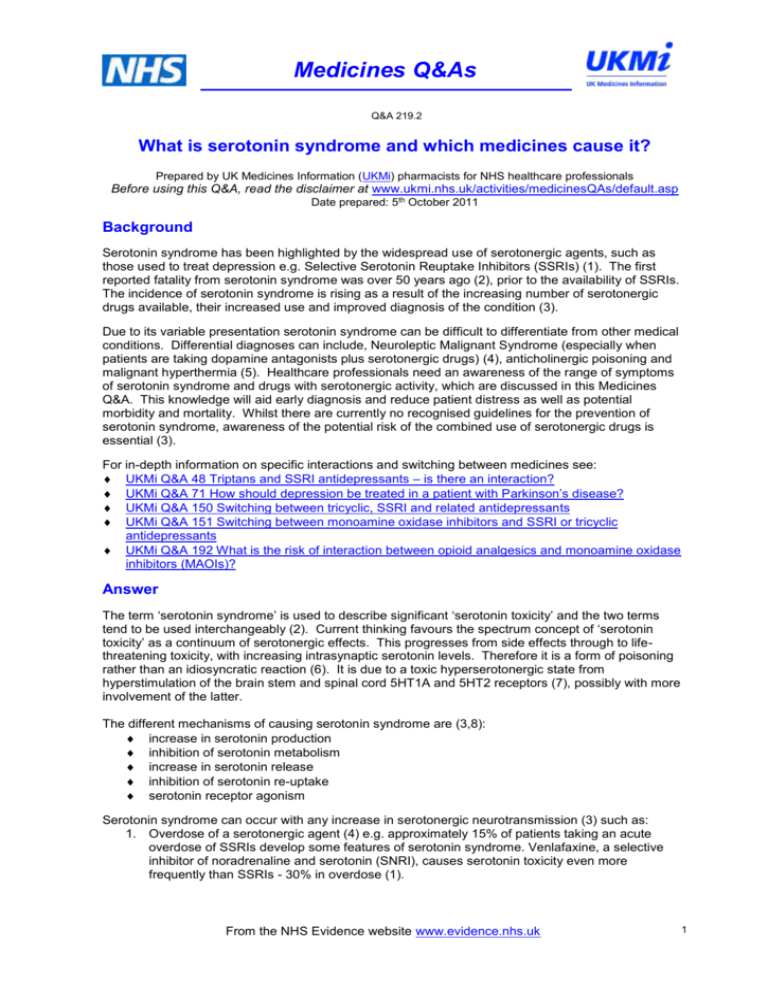
Medicines Q&As Q&A 219.2 What is serotonin syndrome and which medicines cause it? Prepared by UK Medicines Information (UKMi) pharmacists for NHS healthcare professionals Before using this Q&A, read the disclaimer at www.ukmi.nhs.uk/activities/medicinesQAs/default.asp Date prepared: 5th October 2011 Background Serotonin syndrome has been highlighted by the widespread use of serotonergic agents, such as those used to treat depression e.g. Selective Serotonin Reuptake Inhibitors (SSRIs) (1). The first reported fatality from serotonin syndrome was over 50 years ago (2), prior to the availability of SSRIs. The incidence of serotonin syndrome is rising as a result of the increasing number of serotonergic drugs available, their increased use and improved diagnosis of the condition (3). Due to its variable presentation serotonin syndrome can be difficult to differentiate from other medical conditions. Differential diagnoses can include, Neuroleptic Malignant Syndrome (especially when patients are taking dopamine antagonists plus serotonergic drugs) (4), anticholinergic poisoning and malignant hyperthermia (5). Healthcare professionals need an awareness of the range of symptoms of serotonin syndrome and drugs with serotonergic activity, which are discussed in this Medicines Q&A. This knowledge will aid early diagnosis and reduce patient distress as well as potential morbidity and mortality. Whilst there are currently no recognised guidelines for the prevention of serotonin syndrome, awareness of the potential risk of the combined use of serotonergic drugs is essential (3). For in-depth information on specific interactions and switching between medicines see: UKMi Q&A 48 Triptans and SSRI antidepressants – is there an interaction? UKMi Q&A 71 How should depression be treated in a patient with Parkinson’s disease? UKMi Q&A 150 Switching between tricyclic, SSRI and related antidepressants UKMi Q&A 151 Switching between monoamine oxidase inhibitors and SSRI or tricyclic antidepressants UKMi Q&A 192 What is the risk of interaction between opioid analgesics and monoamine oxidase inhibitors (MAOIs)? Answer The term ‘serotonin syndrome’ is used to describe significant ‘serotonin toxicity’ and the two terms tend to be used interchangeably (2). Current thinking favours the spectrum concept of ‘serotonin toxicity’ as a continuum of serotonergic effects. This progresses from side effects through to lifethreatening toxicity, with increasing intrasynaptic serotonin levels. Therefore it is a form of poisoning rather than an idiosyncratic reaction (6). It is due to a toxic hyperserotonergic state from hyperstimulation of the brain stem and spinal cord 5HT1A and 5HT2 receptors (7), possibly with more involvement of the latter. The different mechanisms of causing serotonin syndrome are (3,8): increase in serotonin production inhibition of serotonin metabolism increase in serotonin release inhibition of serotonin re-uptake serotonin receptor agonism Serotonin syndrome can occur with any increase in serotonergic neurotransmission (3) such as: 1. Overdose of a serotonergic agent (4) e.g. approximately 15% of patients taking an acute overdose of SSRIs develop some features of serotonin syndrome. Venlafaxine, a selective inhibitor of noradrenaline and serotonin (SNRI), causes serotonin toxicity even more frequently than SSRIs - 30% in overdose (1). From the NHS Evidence website www.evidence.nhs.uk 1 Medicines Q&As 2. Drug interactions i.e. when more than one drug affecting the serotonin system or inhibiting the metabolism of serotonergic drugs is taken (4). For example, serotonin toxicity is a potential danger of administering two serotonergic antidepressants together (9). In cases of serotonin syndrome due to drug interactions, the most severe cases are seen when monoamine oxidase inhibitors (MAOIs), are taken in combination with SSRIs, tricyclic antidepressants or venlafaxine. This is because the mechanism of action of MAOIs is to inhibit the breakdown of serotonin (8). Also, for example, the addition of drugs that inhibit the cytochrome P450 2D6 and/or 3A4 isoenzymes to therapeutic doses of SSRIs may precipitate serotonin syndrome (3). 3. Taking one serotonergic agent alone in susceptible individuals (10). A complete and accurate medication history is essential when diagnosing serotonin syndrome (3), which usually occurs within a few hours of drug or dose changes, resolving within about 24 hours of stopping the serotonergic drug(s) (7). The onset of symptoms is rapid, with 60% of patients presenting within 6 hours of the initial precipitating factor (11). Symptoms Serotonin syndrome or toxicity results in certain symptoms consisting of a triad of features: alteration of mental status, neuromuscular hyperactivity and autonomic instability (1,2). These three features are not necessarily present together in every patient (1,8). Clinical features can range from mild to life-threatening (12). Around 40% of patients have mental status changes, about 50% of patients have evidence of neuromuscular hyperactivity. Autonomic instability occurs in around 40% of patients (8). Biochemical abnormalities associated with the serotonin syndrome include metabolic acidosis, elevated creatine kinase and transaminase activity and renal impairment (1). Table 1. Symptoms of Serotonin Syndrome (1) (See Glossary after Summary) Alteration of mental status agitation confusion delirium hallucinations drowsiness coma Neuromuscular hyperactivity profound shivering tremor teeth grinding myoclonus ocular clonus spontaneous clonus hyperreflexia Autonomic instability dilated pupils diarrhoea profuse sweating flushing tachycardia hypertension or hypotension In severe cases, hyperthermia, rhabdomyolysis, renal failure, and disseminated intravascular coagulopathy may develop (1). Several systems of diagnostic criteria exist, for example the Sternbach criteria and the Hunter Serotonin Toxicity Criteria. A strict application of the Sternbach criteria could mean missing mild, early or subacute cases (13). The Hunter criteria include clonus, which is more specific to serotonin toxicity (10). Hunter serotonin toxicity criteria – in the presence of a serotonergic agent include any of (1): Spontaneous clonus Inducible or ocular clonus AND agitation or diaphoresis Tremor AND hyperreflexia Hypertonia AND hyperpyrexia (temperature exceeding 38ºC) AND ocular/inducible clonus Causative medicines Serotonin syndrome can be caused by certain drugs alone (usually in overdose) or combinations of serotonergic drugs. Clinicians should be aware of drugs that have serotonergic effects and avoid their concurrent use (1). Some of these medicines are in therapeutic groups that would not normally be associated with use in depression, or psychiatry in general, so their serotonergic effects are not immediately apparent. These include drugs such as bupropion, which has weak SSRI activity, and linezolid or selegiline, both of which have MAOI activity (1). See Table 2 below for further examples. Tricyclic antidepressants (TCAs) non-specifically inhibit neuronal amine uptake. Each have differing potencies as serotonin reuptake inhibitors, which affects their ability to cause serotonin toxicity. From the NHS Evidence website www.evidence.nhs.uk 2 Medicines Q&As Observational data suggest that most TCAs appear not to cause serotonergic effects either in overdose or in combination with an MAOI - but clomipramine and imipramine are the exceptions. Clomipramine may cause severe serotonin toxicity and fatalities have been reported (1). Irreversible MAOIs (e.g. phenelzine, tranylcypromine) are dangerous in combination with SSRIs. Patients exposed to this combination show a very high occurrence of the toxic serotonin syndrome fatalities have been reported. When switching from an SSRI to an MAOI, a washout period of at least 5 times the half-life of the SSRI is recommended to prevent serotonin syndrome (5). See UKMi Q&A 151 Switching between monoamine oxidase inhibitors and SSRI or tricyclic antidepressants, for further details on switching both ways i.e. to and from MAOIs. Table 2. Examples of medicines with potential to cause serotonin syndrome (1,3,12,13,14) Therapeutic group SSRI antidepressants SNRI antidepressants MAOI antidepressants Tricyclic antidepressants Miscellaneous Opioids Parkinson’s disease treatment Antibacterials Anti-cancer drugs Anticonvulsants Antiemetics Antihistamines Antimigraine drugs Anti-smoking aids Anxiolytics Diagnostic dye Herbal products Examples of medicines Citalopram, fluoxetine, fluvoxamine, paroxetine, sertraline Venlafaxine, duloxetine Tranylcypromine, phenelzine, moclobemide (reversible MAO-A inhibitor), isocarboxazid Clomipramine, imipramine Lithium, trazodone, L-tryptophan Pethidine, tramadol, methadone, fentanyl, dextromethorphan, dextropropoxyphene, pentazocine, oxycodone Selegiline (selective MAO-B inhibitor) Linezolid (reversible MAOI activity) Procarbazine Carbamazepine, valproate Promethazine, metoclopramide, ondansetron Chlorphenamine Triptans (See UKMi Q&A 48) e.g. frovatriptan, almotriptan, eletriptan, naratriptan, rizatriptan, sumatriptan, zolmitriptan. Dihydroergotamine. Bupropion Buspirone Methylthioninium chloride (methylene blue) (15) - has reversible MAOI activity(16) St John’s wort Summary The spectrum of ‘serotonin toxicity’ relates to a form of poisoning, not an idiosyncratic reaction. It progresses from mild to life-threatening toxicity, with increasing intrasynaptic serotonin levels (6). Serotonin syndrome is due to a toxic hyperserotonergic state from hyperstimulation of the brain stem and spinal cord 5HT1A and 5HT2 receptors (7), possibly with more involvement of the latter. Serotonin syndrome can occur from an overdose, drug interaction or even single drug therapy in susceptible individuals with a serotonergic agent (10). Symptoms consist of alteration of mental status, neuromuscular hyperactivity and autonomic instability (1,2). Patients do not necessarily have all three features (8). The Hunter diagnostic criteria include clonus which is more specific to serotonin toxicity (10). Medicines potentially causing serotonin syndrome all have some form of serotonergic activity (1,12). Glossary of terms (17) Diaphoresis – (excessive) perspiration Disseminated intravascular coagulopathy – haemorrhagic syndrome following uncontrolled activation of clotting factors and fibrinolytic enzymes resulting in bleeding and tissue necrosis in small blood vessels Hypertonia – extreme tension of the muscles Hyperreflexia – exaggerated response of the deep tendon reflexes From the NHS Evidence website www.evidence.nhs.uk 3 Medicines Q&As Idiosyncratic reaction – abnormal reaction to a medicine Ocular clonus – rapid contractions of the eye muscles Myoclonus – one or a series of shock-like contractions of a group of muscles Rhabdomyolysis – an acute potentially fatal disease that entails destruction of muscle Limitations This Medicines Q&A includes key examples only of medicines available in the UK with the potential to cause serotonin syndrome – the list in Table 2 is not exhaustive. It does not encompass amphetamine and its derivative drugs of misuse, which are also known to cause serotonin syndrome. For further information on this topic please refer to Wills S. Drugs of Abuse. 2 nd edition. London: Pharmaceutical Press; 2005. This Medicines Q&A is based on key review papers i.e. not single case reports. Information on the treatment of serotonin syndrome is beyond the scope of this Medicines Q&A. References 1. Thanacoody RHK .Serotonin syndrome. Adverse Drug Reaction Bulletin 2007;243:931-4 2. Gillman K, Whyte IM. Serotonin syndrome. Chapter 3 in Haddad P, Dursun S, Deakin B,editors. Adverse Syndromes and Psychiatric Drugs: a Clinical Guide. Oxford: Oxford University Press; 2005 p 37-49. 3. Ables AZ, Nagubilli R. Prevention, diagnosis and management of serotonin syndrome. Am Fam Physician 2010; 81(9):1139-1142. 4. Smith FA, Wittmann CW, Stern TA. Medical Complications of Psychiatric Treatment. Crit Care Clin 2008; 24(4): 635-656. 5. Palaniyappan L, Insole L, Ferrier N. Combining antidepressants:a review of evidence. Advances in Psychiatric Treatment 2009;15:90-99. 6. Gillman PK. A Review of Serotonin Toxicity Data: Implications for the Mechanisms of Antidepressant Drug Action. Biol Psychiatry 2006; 59: 1046-1051. 7. Bazire S. Psychotropic Drug Directory: The Professionals’ Pocket Handbook and Aide Memoire. Aberdeen: Healthcomm UK; 2010 p503 8. Thanacoody R. Serotonin syndrome. Medicine 2007;35(10):556-557. 9. Taylor D, Paton C, Kapur S. The Maudsley Prescribing Guidelines 10th Edition. London: Informa Healthcare; 2009 p214-215. 10. Isbister GK, Buckley NA, Whyte IM. Serotonin toxicity: a practical approach to diagnosis and treatment. Med J Aust 2007; 187(6):361-5. 11. Bleakley S. Review of choice and use of antidepressants. Progress in Neurology and Psychiatry 2009;13(1):14-20. 12. Sun-Edelstein C, Tepper SJ, Shapiro RE. Drug-induced serotonin syndrome: a review. Expert Opin. Drug Saf. 2008; 7(5):587-596. 13. Boyer EW, Shannon M. The Serotonin Syndrome. N Engl J Med 2005; 352(11):1112-20. 14. Yalug I, Ozdemir S, Aker T. A brief review of serotonin syndrome. Neurology, Psychiatry and Brain Research 2008;15:1-6. 15. Medicines and Healthcare products Regulatory Agency. Methylthioninium chloride (methylene blue): Update on CNS toxicity with serotonergic drugs. Drug Safety Update April 2009; 2(9):3. 16. U.S. Food and Drug Administration. FDA Drug Safety Communication: Serious CNS reactions possible when methylene blue is given to patients taking certain psychiatric medications. 26th July 2011. Accessed via http://www.fda.gov/Drugs/DrugSafety/ucm263190.htm on 11th October 2011. 17. Stedman’s Medical Dictionary for the Health Professions and Nursing. Illustrated 5 th edition. Baltimore, Maryland: Lippincott Williams and Wilkins; 2005. From the NHS Evidence website www.evidence.nhs.uk 4 Medicines Q&As Quality Assurance Prepared by Kate Pickett, Medicines Q&A Pharmacist (based on earlier work by Sandra Hicks), Wessex Drug & Medicines Information Centre, University Hospital Southampton NHS Foundation Trust. Date Prepared 5th October 2011 Checked by Nicola Watts, Senior Medicines Information Pharmacist (based on the Q&A originally checked by Kate Pickett), Wessex Drug & Medicines Information Centre, University Hospital Southampton NHS Foundation Trust. Date of check 26th October 2011 Search strategy Embase (via NLH Search 2.0): exp SEROTONIN SYNDROME/ [Limit to: Publication Year 2007current and (Publication Types Review) and Human and English Language] Medline (via NLH Search 2.0): exp SEROTONIN SYNDROME/ci [ci=Chemically Induced] [Limit to: Publication Year 2007-Current and Review Articles]. NHS Evidence. Accessed via http://www.evidence.nhs.uk/ In-house textbooks From the NHS Evidence website www.evidence.nhs.uk 5
